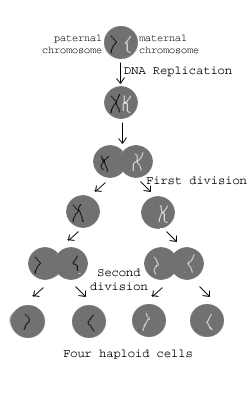Mitosis and meiosis are similar processes in that they both result in the separation of existing cells into new ones. They differ, however, in their specific processes as well as in their products. The reason for these differences lies in the difference in the class of cells that each process creates. Mitosis is responsible for reproducing somatic cells and meiosis is responsible for reproducing germ cells. In this section, we will review the major differences between these two processes and explain why such differences exist.
Mitosis
In single-cell organisms, mitosis is the only form of cellular reproduction. One round of mitosis yields two genetically identical cells. In bacteria, this process results in an entirely new, independent organism. This is classified as asexual reproduction because it does not require sex for the creation of new organisms. In multi-cellular organisms, like ourselves, mitosis only occurs in somatic cells, which comprise all cells in an organism excluding germ cells.

Cells that undergo mitosis duplicate their chromosomes, resulting in cells with two times their normal haploid or diploid numbers (4N chromosomes). Newly-synthesized chromosomes remain closely associated with their like-chromosome. These two identical chromosomes are called sister chromatids. Once duplicated, sister chromatids separate such that one copy of each chromosome lines up on opposite ends of the cell. The cell then pinches in the center until it breaks into two different cells. A nucleus then forms around the chromosomes in each cell to yield two cells with the same original number of chromosomes as the preexisting cell.
Meiosis
There are two major differences between mitosis and meiosis. First, meiosis involves not one, but two cell divisions. Second, meiosis leads to the production of germ cells, which are cells that give rise to gametes. Germ cells are different from somatic cells in a critical way. Whereas somatic cells are diploid, meaning they have two copies of each chromosome, germ cells are haploid. The haploid nature of germ cells is vital to the process of sexual reproduction.
There are two different sex cells or gametes: sperm and eggs. Males produce sperm and females produce eggs. Because they are produced from germ cells, gametes are likewise haploid. In order to create a new individual via sexual reproduction, a sperm cell needs to activate an egg by joining it in a fertilization process. When these two haploid cells unite, a diploid cell results. This specialized cell can then develop into a new individual. The sexual reproductive process just described ensure that the resulting offspring will have an equal maternal and paternal genetic contribution.

As we mentioned earlier, higher-order cells contain homologous pairs of chromosomes--one from the father and the other from the mother. In meiosis, as in mitosis, the maternal and paternal homologues are replicated during DNA replication yielding two pairs of sister chromatids. After the first cell division, each of the resulting cells contains a pair of sister chromatids—-one maternal pair and the other paternal. Unlike mitosis, meiosis does not end after one division; it continues with a second cell division. In this division, the sister chromatids are separated yielding four total haploid cells.
The specific events that occur during both mitosis and meiosis are much more complex than described above and will be covered in depth in the following SparkNote on cell reproduction. This is just meant to be an introduction to the general concepts behind the two processes and as a means to introduce terms that will ease understanding of more complex explanations.


 payment page
payment page



